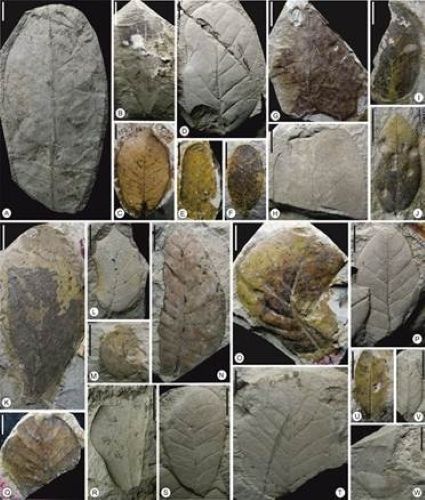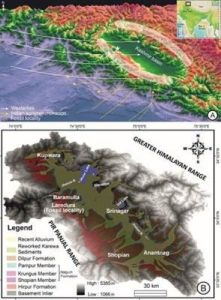Kashmir was once a humid subtropical paradise, says a DST study

Fossil leaves excavated from the Kashmir Valley belonging to ~4 million years in age.
Team L&M
A ground breaking study by Indian Scientists has revealed that the Kashmir Valley, now known for its cool, Mediterranean-type climate, was once a warm, humid subtropical paradise. This ancient climate, long buried in the past, has been resurrected by probing fossilised leaves and mountain-building forces.
As part of the rich fossil leaf collection curated by the late Prof. Birbal Sahni and Dr. G.S. Puri, housed at the Birbal Sahni Institute of Palaeosciences (BSIP), Lucknow, an autonomous institute of the Department of Science and Technology (DST) were collections recovered from the Karewa sediments of the Kashmir Valley. These displayed remarkable diversity and preservation. Many of the specimens resembled subtropical taxa that no longer exist in the region’s current temperate climate.
Map showing the location of the fossil locality situated
in the Kashmir Valley
A group of researchers from BSIP were intrigued by the striking mismatch between past and present vegetation and this prompted their scientific investigation into the climatic and tectonic history of the Kashmir Valley using modern palaeobotanical methodologies.
Dr. Harshita Bhatia, Dr. Reyaz Ahmad Dar and Dr. Gaurav Srivastava linked this dramatic shift to the tectonic uplift of the Pir Panjal Range, a sub-Himalayan Mountain range that gradually rose and blocked the Indian summer monsoon from reaching the valley.
Leaf fossils reveal how Himalaya rewrote Kashmir weather 4-Million-Years ago
By doing so, these rising mountains cut off the water supply, drying out the lush forests and transforming the region’s climate from subtropical to Mediterranean over millennia.
Using CLAMP (Climate Leaf Analysis Multivariate Program) the Scientists examined the shape, size and margins of fossil leaves to determine temperature and rainfall patterns and cross-checked fossil plants with their modern relatives with the help of the coexistence approach to estimate climate ranges. This helped them create a detailed snapshot of the Kashmir Valley’s ancient environment, rich with warmth and rain—until the mountains intervened.
A Journey into the past
This study published in the journal Palaeogeography, Palaeoclimatology, Palaeoecology is not only a journey into the past but also a window into our climate future. Understanding how tectonic forces shaped the climate millions of years ago gives us critical insights into how Earth’s systems respond to change.
As modern climate change continues to alter rainfall and temperature patterns, research like this helps Scientists build better models to predict how ecosystems might adapt—or collapse—in the face of these shifts. It’s also a key to conserving fragile mountain regions like the Himalayas, which are highly sensitive to environmental change.



1 Comment
Nice that Indian science is busy separating wheat from chaff finding wheat in most! Kashmir was recorded as Rishi Kashyap Valley with Lakes and green ecology in all ancient Indian records .